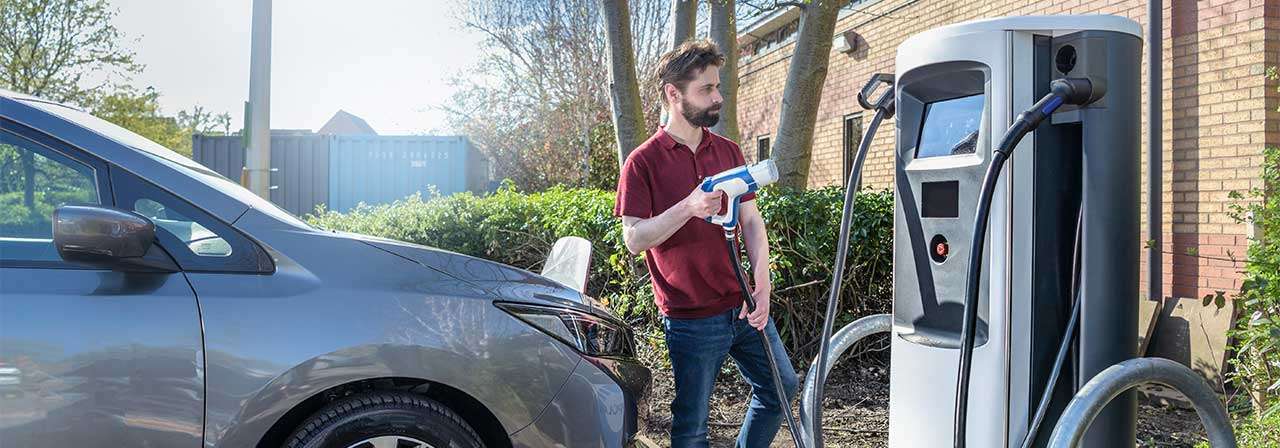How can real estate power up for the electric vehicle surge?
EV charging points are lagging behind a global uptick in zero emission car sales – but the answer could lie in destination charging points
As sales of electric vehicles rise steadily, charging infrastructure is playing catch-up with the help of innovative technology and growing involvement from local authorities and developers.
Electric vehicles accounted for 4.2 percent of global light vehicle sales last year, up from 2.5 percent in 2019, according to industry tracker EV Volumes.
And that’s set to soar as more car manufacturers ramp up their EV production. BMW, for example, expects that around a third of its production will be electric as soon as 2025, meanwhile Ford, Volvo and Bentley pledge to be fully electric by 2030. Volkswagen has a €35 billion investment planned, including six European battery cell factories by 2030.
With such momentum building, providing power for EV growth is a challenge for the built environment, says Andrew Mercer, head of energy services at JLL.
“Spurred on by rising EV uptake and their own sustainability efforts, real estate occupiers and investors are now looking more closely than ever at the charging infrastructure needed,” he says. “From shopping centres to hotel car parks, more EV power points are being installed but many more are still needed.”
There are just 40,000 charging points for 1.6 million EVs in the U.S, according to the country’s Department of Energy. The UK, which has around 30,000 charging points, is estimated to need some 214,100 by 2050, according to JLL data.
Adding more charging points
Progress is being made albeit slowly; in Germany, the number of EV charge points rose by 10 percent between January and March to 39,538, according to the country’s Federal Association of Energy and Water Management.
In the UK, supermarkets are prime territory for new installations. Tesco is planning EV charging at 600 sites while supermarket chain Lidl is adding 350 chargers by 2022 at its UK stores.
Such moves are increasingly being driven by necessity as well as demand; in 2019, the UK government stipulated that non-residential buildings with more than 10 parking spaces and undergoing major renovation are required to install at least one EV charger as well as cabling routes at one in five parking spaces. Large existing non-residential buildings with more than 20 parking spaces are required to install at least one charger by 2025.
Getting ahead of the crowd could be an advantage in attracting consumers who own EVs, says Lee Brannan, national EV project manager at JLL’s Integral in the UK.
“Offering low cost or even free power for shoppers may make sense given the competitive nature of the grocery industry.”
Some of the charging points in Tesco, for example, will be free but Brannan expects longer-term most will be paid for.
“There are some parallels with the way bars and cafes have offered customers a socket for phone charging,” he adds. “But the idea of free charging is most likely going to be a temporary one as uptake in EV use rises and providers see the revenue potential.”
Double speed
Fast-charging, where a new generation of batteries can be fully charged in as little as five minutes, is emerging, despite its extremely high kilowatt charging consumption.
British petrol station operator Motor Fuel Group is investing £400 million in fast-charging points at around 500 locations by 2030. Madrid is upgrading its fast-charging station network by 2023.
“We could well see a two-tier EV charging market emerge,” says Brannan. “Faster charging – of less than an hour – could combine well with restaurants, supermarkets and retail parks.”
Conversely, workplaces or hotels could be better suited to slow charging times.
Yet encouraging more businesses and landlords to provide charging points may require stimulus; in Austria, companies and public bodies can make use of subsidies are on offer to buy and install public EV charging points until the end of 2021.
Going the distance
More charge points will go some way to assuaging concerns over drive times in between charges, especially on longer journeys. Yet these are needed along major routes as well as in urban areas.
It’s something E.ON Drive & Clever has piloted in Denmark, while work by the European Union continues on EV charging corridors between Denmark, Sweden, Germany and The Netherlands. In the U.S., President Biden recently announced a plan to deploy 500,000 new stations by 2030.
Further impetus is coming from the likes of Shell, which has agreed to buy German on-street charging provider, ubitricity. But despite the emergence of several EV mapping apps to help navigate drivers to charging points, finding places to power up as more EVs hit the road remains a key challenge.
“Momentum is growing but charging point provision is really still only in its early stages. Where to charge – and quickly – is really the issue of the day,” Mercer concludes. “The coming years will determine how much the real estate industry rises to the challenge.”
